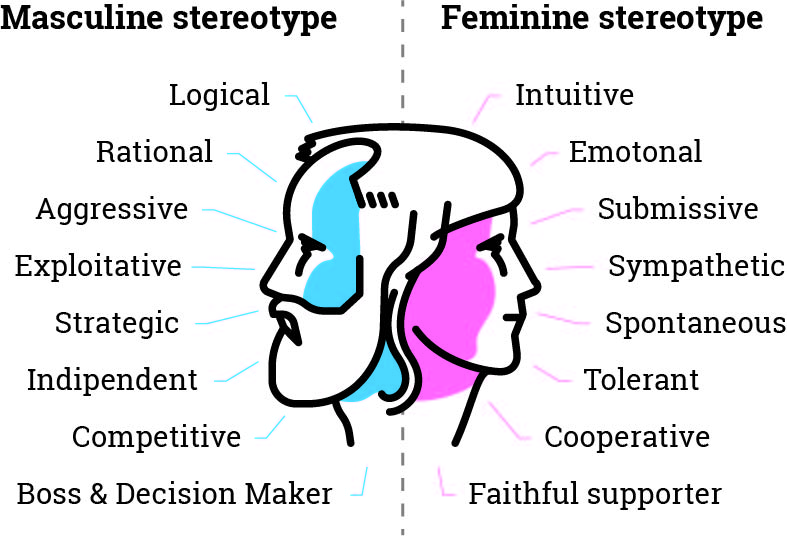Logan Avena // Book Report
Logan Avena
Psychology: History and Systems
Book Report
Testosterone Rex by Cordelia Fine
Testosterone Rex is a novel written by Cordelia Fine, who is a psychologist and professor of history and philosophy of science at the University of Melbourne. She also discusses being a mother throughout the book, which influences much of the point of view throughout the novel. In this novel, Fine addresses the concept called Testosterone Rex, or the long-standing myth that something like testosterone makes male and females brains inherently wired differently (Fine 21-22). This false narrative creates perceived differences that help nobody, such as men are natural risk-takers and science-orientated while women are natural nurturers and humanities-oriented. While gender roles enforce these social differences, there is actually not a masculine and feminine brain that creates these differences. If men and women were socialized differently, society would not see this seemingly inherent divide. Fine uses research studies and science to explain how Testosterone Rex is false.

This novel is split into three parts: Past, Present, and Future. I am going to focus on my favorite chapter of every section. Starting out, my favorite chapter in part one is chapter 2, titled, “One Hundred Babies?” and ranges from pages 46 to 63. This chapter addresses the myth that in the time it takes for a woman to get pregnant and give birth, a man could father one hundred babies. This myth enforces the idea that men are biologically more reproductively successful than women and thus prefer monogamy way less than women. I would say that this also instills the stereotype that men are less invested in their children than women. I liked this chapter because Fine legitimately does the math to figure out the accuracy of this claim. She says that even if a man had one hundred children from one hundred one-night stands, the chance of it happening is a percentage so low, 3.63×10-156 to be exact, that it is nearly impossible. She also cited a study that said on anonymous surveys, roughly the same amount of men and women preferred a long-term relationship to a hook up. This chapter proves that biology does not determine monogamy preferences and I liked the use of math and research to back up that claim.
My favorite chapter from part two is chapter 7, titled, “The Myth of the Lehman Sisters,” and ranges from pages 151 to 170. The chapter starts off with a question posed by the Guardian, if Lehman Brothers had been Lehman Sisters, would the “credit crunch” had happened? Here is an article detailing the economic failure: https://www.independent.co.uk/news/business/analysis-and-features/financial-crisis-2008-why-lehman-brothers-what-happened-10-years-anniversary-a8531581.html. Simply, the crunch was caused partly by giving out risky mortgages. The idea that men are natural risk-takers is discussed in this chapter. Fine cites a few studies that found the differences in risk-taking in the two biological sexes were not as significant as many would believe. In some cases, biological females made more risk-taking choices. Fine also found that when options are presented in a masculine or feminine way (i.e. aggressive vs. creative), it influenced how the sexes viewed them. I would think a way to nullify this is to present opportunities with neutral sounding words. It is interesting that there is actually no biological difference when it comes to risk-taking.

There is actually only one chapter in part three and it is chapter 8, “Vale Rex”, and ranges from pages 173 to 195. Part three focuses on the future, so she opens the chapter by discussing the campaigns to end “for boys” and “for girls” sections of stores that divide toys for meaningless reasons like color or whether it is a barbie doll or a truck. Toys are not inherently gendered, and sections like these only reinforce imaginary differences at a young age. Studies show that children actually prefer gender-neutral toys. What I took from this chapter is the gender inequality can end by not forcing our children to act different ways and play with different toys based on biological sex. It would not fix everything, but gender-neutral toys and unsegregated clothing sections could be a start.
Personally, I enjoyed reading this novel and I am glad I chose it for this project. Out of all the possible books for this project, this one jumped out at me because I wanted to hear about the studies that proved male and female brains were biologically the same. I feel like we all have heard the phrase “act like a man” or “you throw like a girl”. Phrases like these reinforce hurtful stereotypes that actually have no biological basis. Fine uses interesting and thought-provoking research to highlight her points. Her personal stories from being a mom that is raising a boy added a lot of charm to the novel. There was nothing about this novel that I did not like, as I would truly recommend it to everyone looking to retire the myth of Testosterone Rex.
Works Cited
Fine, Cordelia. Testosterone Rex: Myths of Sex, Science, and Society. W.W. Norton, 2018.
Comments
Post a Comment